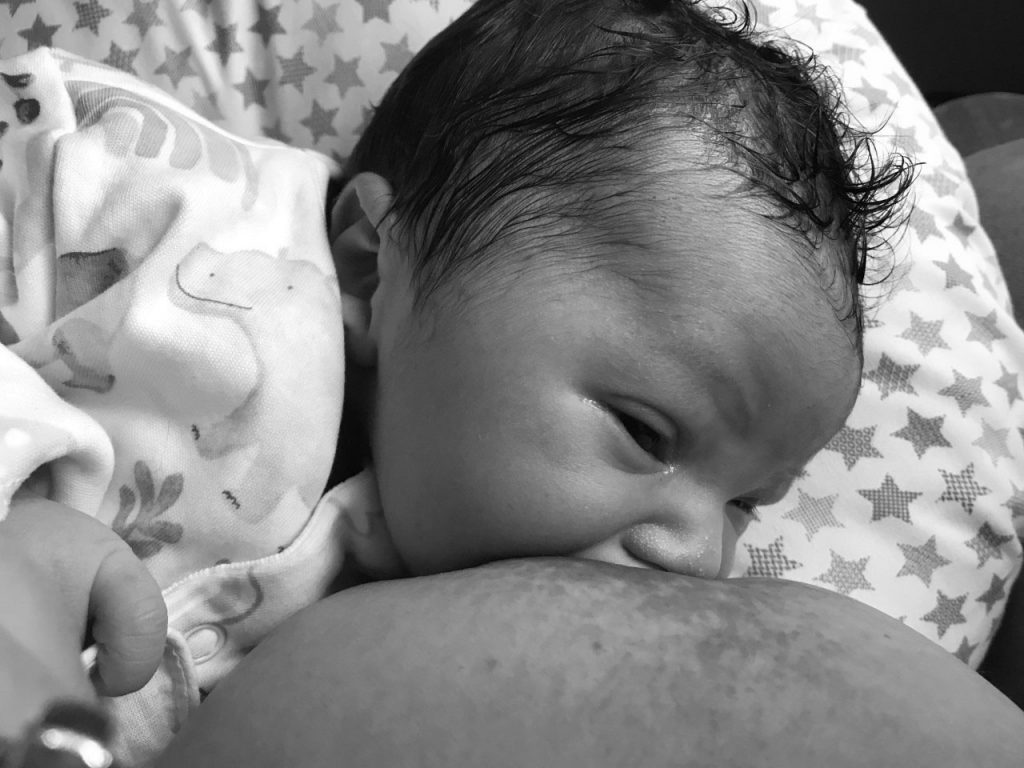Starting off on the right foot can really make your breastfeeding journey more enjoyable from the get-go. A big part of this is being mindful of how your baby latches onto the breast. If a baby latches on well then they will have the best opportunity to withdraw milk and feed effectively. It will also reduce the likelihood of nipple pain in those early days and weeks of breastfeeding.
The steps to take to encourage a good latch
Some babies latch onto the breast straight-away and that’s great! However, for other babies, it’s a skill that needs to be learned.
Even with babies who do latch immediately, their attachment may need to be improved upon to allow for a more optimal feeding experience. This is why it’s important to pay close attention to how your baby attaches to the breast.
- Start by holding baby with the opposite arm to the breast you intend to feed on. Hold baby close making sure their head and body are in a straight line (not twisted towards you).
- Bring their head from the centre of your chest towards your nipple (nose to nipple) whilst supporting their neck, shoulders and back. (Always bring your baby to the breast and avoid ‘posting’ or bending towards baby to put it in their mouth, as this can cause discomfort for you during a long feeding session.)
- Wait for them to open wide, before then allowing them to latch on and begin to suck. For those babies who need coaxing to open up wide, try to tickle their chin, or express a little of your milk onto their lips to encourage them to open up.
- Once baby is latched you may wish to cradle the baby with the other arm for your own comfort.
For those babies who need coaxing to open up wide, try to tickle their chin, or express a little of your milk onto their lips to encourage them to open up.
Knowing how to unlatch your baby
Just as it’s important to know how to latch your baby onto the breast, it’s also important to know how to unlatch them if you suspect their latch is not good or if you are in discomfort. Don’t pull the baby off the breast and risk nipple damage, or think that you just need to suffer in silence until the baby comes off themselves.
Just as it’s important to know how to latch your baby onto the breast, it’s also important to know how to unlatch them
To unlatch your baby, place a clean finger in the side of their mouth between your breast and their gums to break the suction. Then guide the baby’s head away from your chest. You can then try latching your baby again.
Keep eyes on your baby’s latch with the Top-Pop
In those early days and weeks of breastfeeding, it’s important to observe your baby to ensure they are latched on and feeding well. Often the clothes we wear can be a hindrance to feeding and getting baby attached well to the breast, especially if we are in the company of others and trying to feed discreetly. This is when the Top-Pop can come in useful.
Often the clothes we wear can be a hindrance to feeding
Designed by a mother-daughter duo BREAST-FRIEND, the Top-Pop is an eco-friendly breastfeeding accessory that allows you to keep your top up and out of the way for easy feeding. No more faffing with clothes or holding your top up and out of the way with your hand or chin.
With a Top-Pop you can clearly see how your little one is feeding and make any necessary adjustments to their latch. Once you are happy with how your baby is feeding you can attach a BREAST-FRIEND organic muslin cloth to the Top-Pop for more coverage and discreet feeding. This can be particularly useful if out and about, or if you want to limit distractions for your little one.
Knowing a good latch from a ‘bad’ one
One of the best ways to tell if your baby is latched on well is to look and see if your baby’s mouth is open wide and covering a good amount of the areola. Ideally, you should see more of the areola above baby’s mouth than below.
You don’t want your baby just sucking on the tip of your nipple as this will get sore and mean they aren’t getting much milk.
Look and see if your baby’s mouth is open wide and covering a good amount of the areola.
Another good sign is when your milk has come in and you hear your baby rhythmically sucking and swallowing with ease. You’ll likely see some milk around their mouth and hear them swallowing. If your baby stays on the breast throughout a feed (doesn’t come off and on repeatedly) this is also a good sign they are well attached and feeding effectively.
When in doubt, get your baby’s latch checked
If you are suffering from persistent pain or are worried that your baby’s latch is not very good then ask your midwife, or an infant feeding expert to have a look at how your baby feeds at the breast. They will assess their latch and check your baby for tongue-tie, which is a physical condition that can cause a shallow latch and poor feeding mechanism.
The quicker you can help your baby latch on more effectively, the better for everyone. With some guidance you can look to adjust your baby’s latch for the better and from there enjoy a positive feeding experience with your little one.
